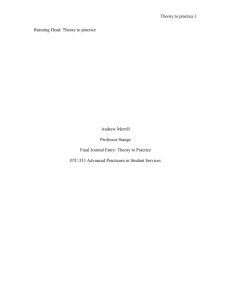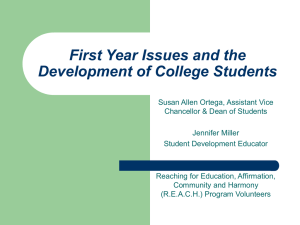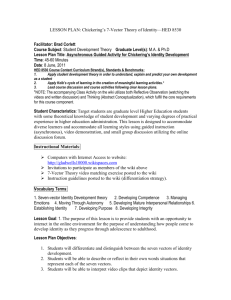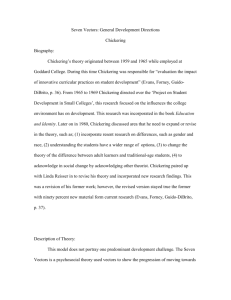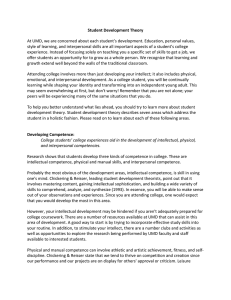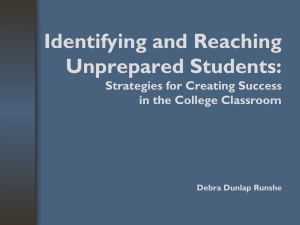Chickerings 7 Vectors
advertisement
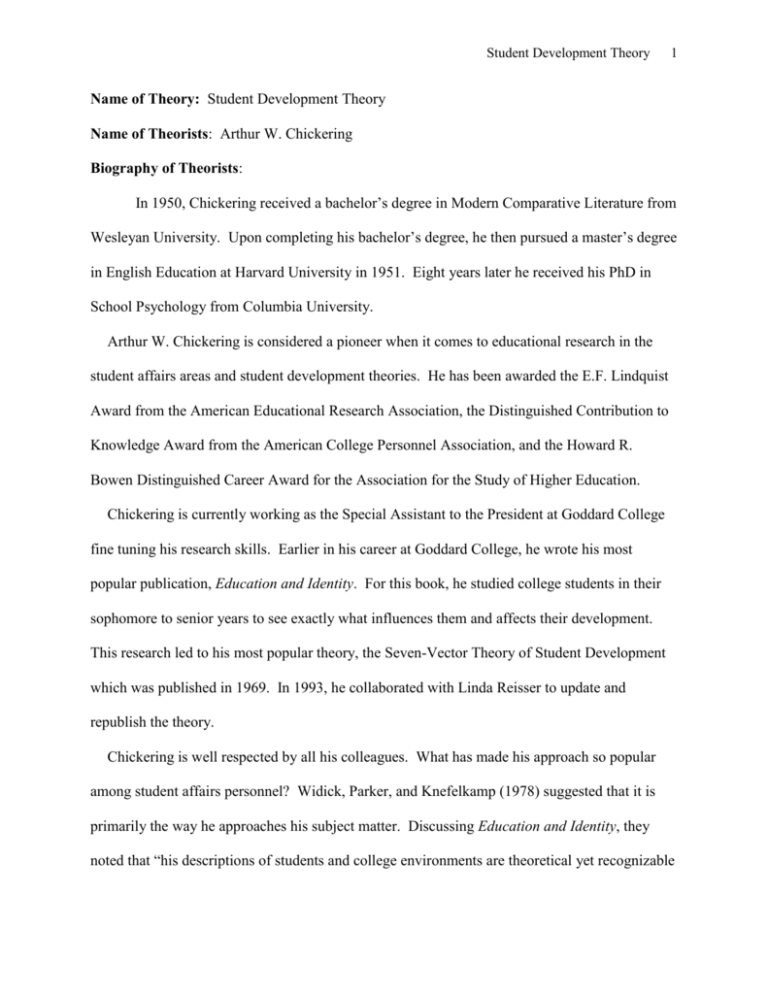
Student Development Theory 1 Name of Theory: Student Development Theory Name of Theorists: Arthur W. Chickering Biography of Theorists: In 1950, Chickering received a bachelor’s degree in Modern Comparative Literature from Wesleyan University. Upon completing his bachelor’s degree, he then pursued a master’s degree in English Education at Harvard University in 1951. Eight years later he received his PhD in School Psychology from Columbia University. Arthur W. Chickering is considered a pioneer when it comes to educational research in the student affairs areas and student development theories. He has been awarded the E.F. Lindquist Award from the American Educational Research Association, the Distinguished Contribution to Knowledge Award from the American College Personnel Association, and the Howard R. Bowen Distinguished Career Award for the Association for the Study of Higher Education. Chickering is currently working as the Special Assistant to the President at Goddard College fine tuning his research skills. Earlier in his career at Goddard College, he wrote his most popular publication, Education and Identity. For this book, he studied college students in their sophomore to senior years to see exactly what influences them and affects their development. This research led to his most popular theory, the Seven-Vector Theory of Student Development which was published in 1969. In 1993, he collaborated with Linda Reisser to update and republish the theory. Chickering is well respected by all his colleagues. What has made his approach so popular among student affairs personnel? Widick, Parker, and Knefelkamp (1978) suggested that it is primarily the way he approaches his subject matter. Discussing Education and Identity, they noted that “his descriptions of students and college environments are theoretical yet recognizable Student Development Theory 2 and realistic; his thinking connects in a very direct way with the experiences of college practitioners” (p. 19). They also summarized Chickering’s special contributions to the field: “Chickering is that rare entity, a scholar-practitioner, who stands between and bridges theoretical knowledge and the realities of practice” (Widick et al., 1978, p. 19). Description of Theory: The Seven-Vector Theory of Student Development began in 1959 when Arthur Chickering was working on the Project on Student Development in Small Colleges. For this project, he surveyed a number of traditional college aged students from their sophomore years to their senior year where he was currently working at Goddard College. When he finished, Chickering combined his data from Goddard with data from other schools involved in the project. From these surveys, Chickering identified seven vectors of student development. In 1969, he published a book on his findings on student development in traditional aged college students, Education and Identity. These seven vectors are stages of development that occur while a student is at college. These stages help students build an identity. Each vector revolves around feelings, beliefs, thoughts and social skills. Although all stages are required, students may experience these stages at different rates. Often their experiences in these vectors trigger stages for other students. The research shows no clear linear pattern for these stages. In fact, Chickering believes that students can go through several stages at the same time. No matter the order, all seven stages must be realized before a college student can truly self-identify. In the early 1990s, Chickering teamed up with Linda Reisser to update his original seven vectors. With all the changes in technology, the different ages of college students and their quickly changing environments, the team wondered if there would be a change in the original Student Development Theory 3 vectors. Surprisingly, this study yielded relatively the same results. Chickering and Reisser made some small changes to his vectors and republished his book titled Education and Identity in 1993. The seven vectors are as follows: Developing Competence, Managing Emotions, Moving through Autonomy, Developing mature Interpersonal Relationships, Establishing Identity, Developing Purpose and Developing Integrity. Developing competence involves growth in a student physically, interpersonally through relationships and skills and intellect growth or knowledge. Reisser (1995) points out three areas of intellectual competence including growth of intellectual, cultural and aesthetic sophistication, acquisition of subject matter knowledge, and changes in one’s reasoning patterns. This growth in critical thinking skills and appreciation of humanities is essential for changes in the student’s prospective. The next vector is managing emotions. The explanation of managing emotions was broadened in the second edition. This vector focuses on the student’s reactions to and expressions of different situations and relationships in their lives. Reisser (1995) points out that “age does not necessarily correlate with emotional maturity”. Even non-traditional students still develop in the emotional management vector. She also points out that many students regardless of age carry more emotional baggage than they did in the 1960s. Students must learn how to handle this baggage, relate to others and build upon their experiences. Moving through autonomy toward interdependence requires students to learn how to be emotionally independent while carrying on interpersonal relationships. This vector addresses students need for reassurance via comfort or approval. As the student moves through the vector they require less outside approval. The second edition points out the different approaches in this Student Development Theory 4 vector are taken by males and females. This edition does not explore any possible differences in the gay, lesbian, bisexual or transgender populations. The next vector focuses on developing mature interpersonal relationships. This development could be with friends, family or significant others. It involves tolerance of differences, appreciation and honest communication. These relationships make the student focus on their feelings, values, sexuality, self-esteem and identity. (Reisser, 1995) The last three vectors are establishing identity, developing purpose and developing integrity, Each of these focus on a series of personal questions. These questions help the students to identify who they are, what they believe in and where their future is taking them. The answers to these questions may change several times during this development process as students are exposed to new knowledge and experiences. Complete development requires a student to move through and realize each vector to fully self-identify. Theory Measurement/Instrumentation: Chickering’s original research and his updated research with Reisser was completed by interviewing a variety of students. At this point and time there is no standard test for measuring or assessing Chickering’s Seven Vectors of Student Development. Other researchers have used a variety of assessments to test the seven vectors. For example, the six Iowa instrument plus an objective measure of cognitive development was used by White and Hood. (Evans, Forney, Guido-DiBrito, p.45) Other tests or assessments have been used to measure specific vectors. Vector 6, Developing Purpose, has been measured by using the Student Developmental Tasks and Lifestyle Assessment-Purpose (SDTLA-PUR) and Frankl’s Purpose in Life Test (PIL). (Molasso, 2006) Student Development Theory 5 Prepared by: Ephanie DeBey and Jennifer Duncan References: Chickering, A.W. (1969). Education and identity. San Francisco, CA: Josey-Bass. Chickering, A.W.; Reisser, L. (1993). Education and identity (2nd ed). San Francisco, CA: Jossey-Bass. Evans, N.J., Forney, D.S., Guido-DiBrito, F. (1998). Student development in college. San Francisco, CA: Jossey-Bass Molasso, W. (2006) Measuring a student’s sense of purpose in life. Michigan Journal of College Student Development, 12(1), 15-24. Reisser, L. (1995). Revisiting the seven vectors. Journal of College Student Development, 36, 505-511. Widick, C., Parker, C.A., & Knefelkamp, L.L. (1978). Arthur Chickering’s vectors of development. In L.L. Knefelkamp, C. Widick, & C.A. Parkers (Eds.), Appling new development findings (New directions for student services, No. 4) (pp. 19-34). San Francisco, CA: Jossey-Bass.
